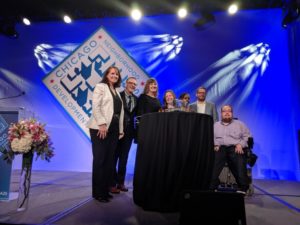Darnell Harris is living on his own for the first time at the age of 47. Thomas Benson now lives in a condo in Buena Park, after transitioning out of a nursing home. Stephany Pantoja is enjoying her peaceful home in Humboldt Park. These are just three of the 200+ residents of IFF’s Home First program, which creates accessible, affordable, community-integrated housing for people with a broad range of disabilities.
In the past year, IFF’s Home First program has been recognized five times for its vision, affordability, and design from local, regional, and national organizations:

- For Vision: Vision Award from the Urban Land Institute (June 2018)
- For Affordability: Community Neighborhood Development Awards (CNDAs) – Polk Bros Foundation Affordable Rental Housing Preservation Award from LISC Chicago (May 2019)
- For Impactful Use of Tax Credits: Charles L. Edson Tax Credit Excellence Award from the Affordable Housing Tax Credit Coalition (June 2019)
- For Design: Housing and Community Design Award for Housing Accessibility: Alan J. Rothman Award from the American Institute of Architects and the Office of the Secretary of the U.S. Department of Housing and Urban Development (June 2019)
- For Leadership: Nonprofit Developer of the Year Award from the Cook County Land Bank Authority (July 2019)
“The recognition Home First has received shows that what we’re doing is unique and innovative,” says Lisa Williams, IFF Director of Universal Access Services. “We want to build on this recognition to replicate Home First in communities across IFF’s footprint and create more critically needed housing for individuals with disabilities.”
 With features like roll-in showers, front-loading appliances, sliding barn-style doors, and lights that flash when someone rings the doorbell, Home First homes are thoughtfully designed for the people they are created to serve.
With features like roll-in showers, front-loading appliances, sliding barn-style doors, and lights that flash when someone rings the doorbell, Home First homes are thoughtfully designed for the people they are created to serve.
But Home First’s accessible design features aren’t the only thing that makes this program unique. They also preserve affordability by leveraging diverse funding sources – Low Income Housing Tax Credits, state and local government funds, Federal Home Loan Bank support, donation tax credits, and private corporate and foundation support. What’s more, Home First projects stabilize neighborhoods by rehabbing foreclosed, vacant properties and building on vacant lots. And by scattering the homes throughout neighborhoods, rather than segregating people with disabilities into a single structure for dozens of people, residents feel more integrated into their community.
These features – accessibility, affordability, and community integration – create a resource-intense process for IFF as the developer. But the social and personal impact of the project far outweigh the costs.
“We’re dealing with multiple property closings and construction sites, we’re incorporating unique design features, and we’re doing it all with a complex mix of financing and rental subsidies to make it all affordable for residents,” says Lead Developer Dena Bell. “It’s the only project of its kind that creates truly community-integrated accessible housing — and it provides a much improved quality of life for the individuals living there.”
IFF’s Home First residents agree – just check out our profiles of Darnell, Thomas, and Stephany to see why.